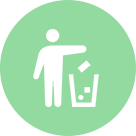About Pediatric Medical Emergencies
On this page you will find information regarding what parents and guardians can do when their child suddenly becomes ill or injured. This information is sourced from the Japanese edition of the Pediatric Medical Emergency Pamphlet, or こども救急パンフレット, which can accessed on its homepage by clicking the link below.
When your child becomes ill or injured over the holidays or during the night
- Pediatric Medical Emergency Telephone Consultations
Fukushima Prefecture Pediatric Emergency Telephone Consultations (#8000)
When your child suddenly becomes ill during the night and you don’t know whether or not to bring your child to the hospital, please call us. You can consult with experienced doctors or nurses about what you can do.Short Dial: #8000 (For fixed phone lines or cellphones)
Or Call: 024-521-3790 (fixed telephone analog line)Hours: Every day from 7:00pm to the following morning at 8:00am.
- Pediatric Medical Emergencies/Early Internal Medicine Emergencies at Night in Minamisoma
Minamisoma Municipal General Hospital
Please contact the hospital before coming to get a consultation.Address: Haramachi, Takami-cho 2-Chome 54-6
Telephone Number: 0244-22-3181
Hours: Weekends, holidays, and December 31st to January 3rd from 7:00pm to 9:30pmYou can also check the city homepage and the distributed Kouhou Minamisoma (広報みなみそうま) for information regarding the on-duty doctors during holidays each month.
Seizures
| Conditions | What to Do |
|---|---|
|
Seizure won’t stop The seizure stopped but your child is unconscious Their lips have become purple Their body temperature during the seizure is 38℃ or below The seizure reoccurs several times Their eyes roll back in their head |
Dial 119. Call an ambulance right away. They will take you and your child to the appropriate medical institution. |
|
If your child has one (or more) of the following conditions: The seizure lasted for 5 or more minutes This is the first seizure your child has experienced The seizure lowered their temperature to 38℃ or below Your child has recently hit their head hard |
Call and take your child to an on duty doctor available at the time of the incident. |
|
When you aren’t certain if it is a seizure or not |
Call the consultation line at #8000 |
Things the doctor will ask during consultations
1. When did it start?
2. What was the seizure like?
3. How long did the seizure last?
4. During the seizure, was there any difference in the movement of the left or right side of the body?
5. What was their temperature at the time of the seizure?
Things you can do at home
Turn their face so that it is sideways and loosen their clothes.
Clear the surroundings of anything that they could hurt themselves on during the seizure.
Using your finger, make sure there isn’t anything in their mouth.
Accidental Ingestion
What to do when your child accidentally ingests something or when a foreign object gets stuck in their respiratory tract (throat, trachea, bronchial tube) is different.
1. When a foreign object is stuck in their respiratory tract
What to do at home
When you notice your child gasping for breath, coughing, or their eyes turning white or black, they may be choking on a foreign object. Please see the illustrations below on how to perform a Heimlich maneuver.

2. When your child accidentally ingests something
What to do at home
The way you treat accidental ingestion largely depends on what was ingested. Some ways to solve accidental ingestion is by drinking water or making the child vomit, but in some cases, forcing your child to vomit might cause more harm.
- Drinking Water
Drinking water can often dilute whatever the child ingested, but in some cases there aren’t any effects.
-
Vomiting

| Ingested Item | Drink Water | Vomiting |
|---|---|---|
| Tobacco: Cigarette butts, leaves | × | 〇 |
| Tobacco: Cigarette-infused liquids | 〇 | 〇 |
| Medicine | 〇 | 〇 |
| Aromatics | 〇 | 〇 |
| Perfume/Lotion | 〇 | 〇 |
| Laundry Detergent/Kitchen Cleaner | 〇 | 〇 |
| Air Fresheners/Bug Spray | 〇 (Don't use milk) | 〇 |
| Wax | 〇 (Don't use milk) | × |
| Air Fresheners for Toilets | 〇 | × |
| White-Out | 〇 | × |
| Synthetic Resin Paint/Quick-Drying Varnish | 〇 | × |
| Chlorine-based chemicals (Ex; for toilets, bleach) | 〇 | × |
| Weed Killer | 〇 | × |
| Pesticides for Gardens/Farms | 〇 | × |
| Nail Polish Remover | × | × |
| Coin Batteries | × | × |
| Kerosene | × | × |
| Gasoline/Petrol | × | × |
Things you mustn’t force a child to vomit
Liquids like kerosene and sunblock, when accidentally ingested, will cause inflammation in the lungs so it is crucial not to force your child to vomit up these kinds of liquids. Acidic liquids and liquids with high alkalinity (chlorine-based chemicals, etc.) will hurt the mucous membrane as it’s forced out, so please do not force a child to vomit up such chemicals.
NOTE: If you do not know what to do, please call your primary physician or contact a poison control center.
Tsukuba Poison Control Center
029-852-9999 (Available 9am to 9pm, all year round)
Osaka Poison Control Center
072-727-2499 (Available 24/7, all year round)
Tobacco Specialist Consultation
072-729-9922 (Taped information available 24/7)
Accidental Falls (Head Injuries) and Drowning
Accidental Falls (Head Injuries)
| Conditions | What to Do |
|---|---|
|
They’re unconscious They’re movements become very lethargic They have a seizure |
Dial 119. Call an ambulance right away. They will take you and your child to the appropriate medical institution. |
|
They repeatedly vomit Blood is coming out from their ears or nose They didn’t cry right away They look pale or unwell They seem absentminded or they doze off |
Call and take your child to an on duty doctor available at the time of the incident. |
|
A large bump appears They cried immediately and after they stopped, they appeared to be alright They are fully conscious |
Please keep an eye on your child’s condition. If your child’s condition worsens, please see a doctor immediately. |
Things the doctor will ask you during consultations
- How did your child hit their head? Did they fall? Tumble over? Were struck by something? Or was the cause something else?
- Where did they fall or tumble over? On tatami? Concrete? Dirt? A gravel road? Or somewhere else?
- If they fell, from how high up did they fall?
Drowning
| Conditions | What to Do |
|---|---|
|
They’re unconscious They’re not breathing |
Dial 119. Call an ambulance right away. They will take you and your child to the appropriate medical institution. |
|
You were able to save them immediately They are conscious |
Please keep an eye on your child’s condition. If your child’s condition worsens, please see a doctor immediately. |
Take Extreme Caution!
Please do not leave small children unattended around open baths or pools.
Burns
| Conditions | What to Do |
|---|---|
|
The skin has been burn to black or white Their whole body or a large portion of their body has been burned |
Dial 119. Call an ambulance right away. They will take you and your child to the appropriate medical institution. |
|
Blisters have appeared The area burned is wider than the child’s hand |
Call and take your child to an on duty doctor available at the time of the incident. |
|
The burned area is small and only red, no blisters have appeared |
Please keep an eye on your child’s condition. Once your usual clinic opens up, you can go to have a consultation with your doctor. However, If your child’s condition worsens, please see a doctor immediately. |
Things the doctor will ask during consultations
What caused your child’s burns? Hot water? Oil? A heater? A rice cooker? A pot? Or something else?
| 1st Degree | The surface of skin is only red and there aren’t any blisters. |
|---|---|
| 2nd Degree | There are blisters on the skin’s surface. |
| 3rd Degree | The skin has been burned to the point of turning black or white, and you can see the hypodermis (layer of flesh under the skin). |
Things you can do at home
- If the degree of the burn is lower than 3rd degree, be sure to keep the burned area under lukewarm or cold water for about 20~30 minutes. If it is too painful for the child to remove their clothes beforehand, you can do this step while wearing clothes as well.
- If the area burned is wide, please place it under a cold, damp towel and go to a medical institution for an examination.
- Please be careful not to pop or break any blisters that appear.
- Until you can see a doctor, using your own judgement, try not to cover the burned area with anything.
Fevers (38℃ or higher)
| Conditions | What to Do |
|---|---|
|
They are not yet 3 months old and have a fever. |
Call and take your child to an on duty doctor available at the time. |
|
They are 3 months to 6 years old and have one or more of the following: They don’t have any energy and seem very lethargic They have teary eyes Their lips are dry They don’t want to drink They have had diarrhea or vomited several times They can’t urinate |
Call and take your child to an on duty doctor available at the time. |
|
Regardless of age: They are energetic They can eat and drink They aren’t in a bad mood They can sleep peacefully |
Please keep an eye on your child’s condition. Once your usual clinic opens up, you can go to have a consultation with your doctor. However, If your child’s condition worsens, please see a doctor immediately. |
Things the doctor will ask during consultations
- What is their temperature?
- How long have they had the fever?
Things you can do at home
- If their temperature is high, use a cool sheet or ice pack on their head, armpits, neck, or thighs to keep them cooled down.
- Give liquids (hot water, barley tea, deionized water for infants, etc.) in small portions.
- If they are sweating, be sure to dry them off and change their clothes.
Vomiting
| Conditions | What to Do |
|---|---|
|
They have vomited several times They are lethargic They also have a fever They are vomiting blood or bile (green fluids) They are having convulsions Their lips are dry They can’t drink |
Call and take your child to an on duty doctor available at the time. |
|
They are energetic They can drink They have an appetite and good mood They don’t have diarrhea or a fever and their condition seems relatively good They’ve only thrown up once or twice |
Please keep an eye on your child’s condition. Once your usual clinic opens up, you can go to have a consultation with your doctor. However, If your child’s condition worsens, please see a doctor immediately. |
Things the doctor will ask during consultations
1. When did they start vomiting?
2. How many times have they vomited?
3. What did their vomit look like?
4. Do they have a stomachache?
Things you can do at home
1. When they sleep, have them sleep on their side.
2. After they vomit, have them drink some liquids (hot water, barley tea, deionized water for infants, etc.) in small portions.
Diarrhea
| Conditions | What to Do |
|---|---|
|
They have frequent diarrhea and are lethargic They have sunken eyes They can’t drink Their lips or the inside of their mouth is dry They have a fever 38℃ or higher There is blood in their stool |
Call and take your child to an on duty doctor available at the time. |
|
They can urinate Their appetite hasn’t changed They drink a lot They are energetic and in a good mood |
Please keep an eye on your child’s condition. Once your usual clinic opens up, you can go to have a consultation with your doctor. However, If your child’s condition worsens, please see a doctor immediately. |
Things the doctor will ask during consultations
1. How often have they defecated?
2. What have they ate or drank recently?
3. What color is their poop? White? Black? Red? Green? Something else?
4. Does anyone else in the house have diarrhea?
Things you can do at home
- Drink plenty of liquids (hot water, barley tea, deionized water for infants, etc.)
- In order to prevent the illness from spreading, make sure to wash your hands thoroughly after assisting in cleaning up the sick child until they are completely better.
Cough
| Conditions | What to Do |
|---|---|
|
They have a fever higher than 38℃ and have coughed several times They seem lethargic Their lips are purple It seems painful for them to breathe They can’t drink Their face looks blue They seem to have difficulties breathing (gasping for air frequently, breathing fast, etc.) |
Call and take your child to an on duty doctor available at the time. |
|
They are energetic They have an appetite They are coughing but it doesn’t seem painful and they can sleep on their side |
Please keep an eye on your child’s condition. Once your usual clinic opens up, you can go to have a consultation with your doctor. However, If your child’s condition worsens, please see a doctor immediately. |
Things the doctor will ask during consultations
- Is anything blocking their airway?
- Is there anything unusual about the way the coughing sounds?
- Do they have any allergies?
Things you can do at home
- Monitor the temperature of the room and be careful of dry air.
- If their cough is really bad, turn on the humidifier.
- Even if they don’t have an appetite, make sure they at least take in fluids.
Nosebleeds
| Conditions | What to Do |
|---|---|
|
Even after applying pressure, the bleeding doesn’t stop after 20 minutes |
Call and take your child to an on duty doctor available at the time. |
|
The bleeding stops after applying pressure |
Please keep an eye on your child’s condition. Once your usual clinic opens up, you can go to have a consultation with your doctor. However, If your child’s condition worsens, please see a doctor immediately. |
Things you can do at home
- Lower your head in a position so that your child doesn’t end up ingesting blood.
- Make sure there is nothing inserted in the nose before pinching the nostrils shut to stop the blood flow.
- Keep the pressure applied for about 15 minutes, or until the bleeding stops.
Bleeding (From Cuts and Scratches)
| Conditions | What to Do |
|---|---|
|
They are bleeding a lot They seem lethargic The wound is large and/or deep The bleeding isn’t excessive but there is dirt or glass embedded in the wound that can’t come out with running water |
Dial 119. Call an ambulance right away. They will take you and your child to the appropriate medical institution. |
|
Their skin was pierced by old nails or other dirty objects You can’t remove the object that pierced the skin They have a fever and their wound is oozing |
Call and take your child to an on duty doctor available at the time of the incident. |
|
The wound is small or shallow |
Rinse and clean the wound thoroughly and apply a bandage or ointment. Keep a close eye on the wound for any changes. |
Things you can do at home
- Cover the wound with a clean cloth and apply light pressure if the wound is shallow, or strong pressure if the wound is deep in order to stop the bleeding.
- If it is difficult to stop the bleeding, raise the wound up over the height of their heart if possible.
- Thoroughly wash and disinfect the wounds to prevent infection.
Bee Stings and Animal Bites
| Conditions | What to Do |
|---|---|
|
After being stung, they break out in hives and they look sickly It becomes difficult for them to breathe They have been stung several times |
Dial 119. Call an ambulance right away. They will take you and your child to the appropriate medical institution. |
|
They are energetic They don’t have any symptoms other than being a little itchy |
Please keep an eye on your child’s condition. If your child’s condition worsens, please see a doctor immediately. |
| Conditions | What to Do |
|---|---|
|
They were bitten by a wild animal (ex, wild boar, monkey) They were bitten by a snake They were bitten by a stray animal (ex, dog or cat) After cleaning the wound, the wound has become very swollen After cleaning the wound, they start to have difficulties breathing and are gasping for air |
Call and take your child to an on duty doctor available at the time of the incident. |
|
They were bitten by a pet hamster or guinea pig Other than the bite wound hurting, they appear to be fine |
Please keep an eye on your child’s condition. If your child’s condition worsens, please see a doctor immediately. |
Things the doctor will ask during consultations
- What kind of bee stung your child? (If you have the bee’s carcass, bring it with you.)
- What kind of animal bit your child? Snake (If so, do you know the type)? A wild animal? A stray cat or dog? Something else?
- Has your child received all their vaccines so far?
Other Useful Information
Giving Your Child Medicine

Calling an Ambulance

Map of Minamisoma Hospitals, Clinics, and Dental Clinics
Map of Minamisoma Hospitals, Clinics, and Dental Clinics (PDFファイル: 1.9MB)
List of Minamisoma Hospitals, Clinics, and Dental Clinics
List of Minamisoma Hospitals, Clinics, and Dental Clinics (PDFファイル: 120.9KB)
- この記事に関するお問い合わせ先
- このページに関するアンケート
-
より良いウェブサイトにするために、このページのご感想をお聞かせください。















更新日:2021年12月22日